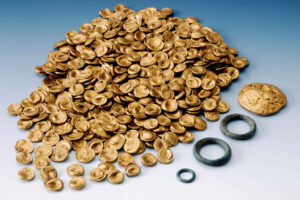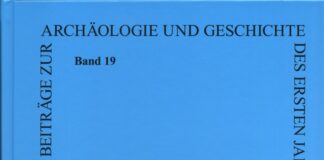Berlin, Dresden, Manching. Once again there was a sensational burglary in a German museum. Many people in the numismatic world will be familiar with the treasure that was stolen this time. It is the Manching coin hoard, consisting of about 500 Celtic gold coins.

The hoard was the key exhibit of the Celtic and Roman museum in Manching near Ingolstadt. The museum is located near the former Celtic Oppidum of Manching, one of the most important and largest Celtic settlements we know of. The finds from the settlement are on display in the museum, including this very gold treasure. It was found in 1999 and considered a great sensation, the largest Celtic gold hoard of the 20th century. Since 2006, the hoard was on display in the museum – until it was stolen this week.

The Sequence of Events
So far, little is known about the sequence of events. On 22 November 2022 at 1:26 a.m., several perpetrators are believed to have entered the museum by forcing open an outside door of the building. They broke open the showcase that contained the hoard and took the gold. Another showcase with coins is also said to have been broken open. At 1:35 a.m., and thus only 9 minutes after their entrance, they already left the building again. It was not until the morning that museum employees noticed the crime.
Wait a minute – you might ask – was there no alarm? There was! Manching’s mayor referred to the museum as a “high-security facility” and the police confirmed that the alarm went off in the museum. But the connection to the security firm was severed, so the alarm never got there. According to the current state of investigation, this is probably due to another crime that occurred in Manching during the same night. According to media reports, several fibre optic cables were cut in a Telekom technical room, interrupting the phone and internet connections of 13,000 homes in the Manching area, including the museum. At least did the regional CID state they secured the museum’s video recordings, which will now be evaluated.
Even the regional CID described the course of events to the media “just like you would imagine it to happen in a bad movie.” Even alarm systems do not seem to be immune to such an attack on the infrastructure – but how can museums effectively protect themselves against such crimes? The events leave people with an oppressive feeling: if there’s enough criminal energy, it will find a way.
Of course, this brings back memories of the burglaries in Berlin and especially Dresden, where perpetrators destroyed a power distribution unit to switch off street lights. A clan known to the police was behind both crimes.

The Hoard
The stolen coins are 483 Bohemian shell staters, created at the end of the 2nd / beginning of the 1st century BC. The pieces with a weight of about 7.2 grams each were probably minted in different places in Central Bohemia and are adorned with crosses, lines and spheres. This means the coins do not originate from Manching. In the past, it was speculated that they might constitute the savings of a merchant who moved there from Bohemia. Moreover, a so-called Goldgusskuchen (“gold cast pie”) was among the hoard, whose weight of 217 grams corresponds that of 30 individual coins.

The Value
In addition to its hardly quantifiable cultural-historical value, the hoard is obviously also of material value. The Director of the Archaeological Collection in Munich quantified this value at 1.6 million euros on Wednesday afternoon. However, it is not that easy to sell the well-documented coins, especially not at normal market price. As with past heists of this kind it is to be feared that the perpetrators will make do with the precious metal value of the coins, melting down the priceless, centuries-old hoard – a terrifying scenario. The 3.72 kilograms of gold have a material value of very roughly 200,000 euros. The cultural loss would be devastating. It can only be hoped that the police have learned enough from the investigations in Berlin and Dresden to be able to catch the criminals and to prevent this from happening. But so far, there is no trace of the perpetrators.
Call for Witnesses
The Bavarian Criminal Investigation Department is asking the public for assistance and poses the following questions:
- Did anyone notice suspicious persons during that night in the area of the Celtic and Roman museum?
- Did anyone notice something suspicious in the vicinity of the museum prior to the crime that might be connected to the heist?
- Can anyone else provide relevant information about the crime, the perpetrators or the stolen gold coins?
Information can be given to the Bavarian Criminal Investigation Department at +49 89 / 1212 – 0 or to any other German police station.
Under the tag “crime” you can find numerous reports on the heists of recent years.
In October 2022, there was a break-in at Moers Castle.
Right before the brazen break-in in Dresden, burglars targeted a hoard of 2500 gold coins in the Trier State Museum in October 2019. However: not all break-ins at German museums are successful!
Here you can get to the website of the Celtic and Roman museum of Manching.




